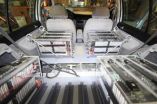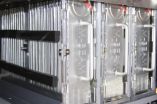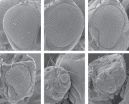(Press-News.org) Imagine being able to switch out the batteries in electric cars just like you switch out batteries in a photo camera or flashlight. A team of engineers at the University of California, San Diego, are trying to accomplish just that, in partnership with a local San Diego engineering company.
They have developed smaller units within the battery, called modules, and a battery management system that will allow them to swap out and recharge the modules, rather than swapping out the whole battery, which is cumbersome and requires large, heavy equipment. They recently presented their findings at the IFAC World Congress in Cape Town. They named the project Modular Battery Exchange and Active Management, or M-BEAM for short (http://www.modularexchange.com).
"This is a game-changing technology," said Lou Shrinkle, an electrical engineer who is one of the major sponsors of the project. "This idea may seem straightforward, but there were some tough technical challenges that we had to solve to make this system robust and practical."
Swapping battery modules could also have far-reaching implications for mobile and decentralized electrical energy storage systems such as solar backup and portable generators. The technology can make energy storage more configurable, promote safety, simplify maintenance and eventually eliminate the use of fossil fuels for these applications, Shrinkle pointed out
"This requires a completely different way of thinking on battery management," said Raymond de Callafon, a mechanical engineering professor at the Jacobs School of Engineering at UC San Diego. "Electric storage capacity is increased when modules are connected in parallel, but this requires a careful control of stray currents between modules."
Algorithms for Charge Estimation and Current Control
A team led by de Callafon is designing the algorithms for charge estimation and current control, implemented in an embedded system that is part of the battery management system for each module. The algorithms will be able to handle battery modules with different charge levels, chemistry, age and condition and keep the modules working together uniformly. The team has published their findings in a recent paper titled "Current Scheduling for Parallel Buck Regulated Battery Modules" in the IFAC World Congress held in Cape Town, South Africa in August, 2014.
Xin Zhao, the graduate student that is part of the team, explains in the paper that rechargeable, removable battery modules in electric cars would solve numerous problems. Being able to simply swap and combine battery modules would eliminate range anxiety and extend the range that cars are able to travel indefinitely — the average range of most affordable electric vehicles is about 70 to 100 miles per charge. Batteries themselves take 4 to 12 hours to charge with conventional power sources. Newer, fast-charge technology still takes about 30 minutes and involves running very high power through batteries, shortening their lifetime and reducing safety.
In the paper, researchers demonstrate that several scheduling algorithms can run within a battery management system when battery modules are connected in parallel, despite changes in the battery operating parameters or battery chemistry. The battery management system decreased the energy loss within the modules and allows the modules being discharged sequentially, which enhances the overall flexibility of the battery system.
Cross-country Trip
Engineers not only believe that their approach is viable, but also plan to prove it. They will embark on a cross-country trip with a car powered by the removable, rechargeable M-BEAM battery modules. They plan to drive from coast to coast only taking breaks that are a few minutes long to swap out the modules that will be recharged in a chase vehicle. They believe they can drive from San Diego to the coast of South Carolina less than 60 hours—without going over the speed limit.
Engineers have already purchased and converted a car, a 2002 four-door Volkswagen Golf. They also built all the modules for one of the two battery packs they plan to use and are now looking for sponsors for their project, including companies or individuals that appreciate the benefits of having small exchangeable battery modules in an electric vehicle.
What Would Change
The team says there are many advantages in their approach of recharging and swapping out smaller modules within a large battery. The approach allows for a separation between the purchase of an electric vehicle and its battery pack. The price of electric vehicles would drop by about $10,000 if removable battery modules are leased rather than built into an electric vehicle.
Also, as of today, more than 40 percent of people living in cities don't have access to wall outlets to charge their electrical vehicles at the curb or in a garage. Exchangeable modules could be taken out of the car and recharged at home. Exchangeable modules would also allow an expanded mix of chemistries and energy densities lowering costs and improving range. Removable batteries could even be brought into the home to be charged and be part of an electricity back-up system.
Challenges and Future Work
But there are challenges. At 20 to 30 lbs. each, the modules are not exactly light-weight. Researchers believe that as battery technology matures, module size will shrink to about the size of a tissue box, weighing less than 10 lbs. The ability to swap battery modules from an electric vehicle allows easy adaptation of such new battery technology.
A battery system based on exchangeable modules would also need an infrastructure that allows users to lease or purchase the rechargeable modules. Businesses that either charge the modules or rent out pre-charged modules would also need to be available throughout the country. But engineers point out that electric vehicle charging stations, especially fast-charge stations, are not widely available either. Exchange stations could easily be gradually deployed. Imagine simply exchanging your modules at the local gas station that charges them for you, much like you can fill up propane tanks today.
Electric shock can also be a risk during removal and replacement of high voltage modules. The battery management system developed by the research team ensures that the output voltage of the battery is equal to zero unless the battery is in the vehicle and enabled by a key switch. Modules are configured to exhibit only safe low voltages even when fully compromised during and after a crash and have built-in solid-state switches to handle a short circuit condition.
Professor de Callafon is excited about the design and testing of the battery modules using a cross-country trip with an electric vehicle. "The cross-country trip will generate a wealth of scientific data on the performance of the battery modules we have designed." The team hopes that the cross-country trip will change the way we think about mobile energy storage for electric transportation.
INFORMATION:
Engineers develop algorithms to switch out and recharge battery modules in electric cars
2014-09-17
ELSE PRESS RELEASES FROM THIS DATE:
US health system not properly designed to meet needs of patients nearing end of life, says IOM
2014-09-17
WASHINGTON -- The U.S. health care system is not properly designed to meet the needs of patients nearing the end of life and those of their families, and major changes to the system are necessary, says a new report from the Institute of Medicine. The 21-member committee that wrote the report envisioned an approach to end-of-life care that integrates traditional medical care and social services and that is high-quality, affordable, and sustainable. The committee called for more "advance care planning" for end-of-life by individuals, for improved training and credentialing ...
First blood test to diagnose depression in adults
2014-09-17
CHICAGO --- The first blood test to diagnose major depression in adults has been developed by Northwestern Medicine® scientists, a breakthrough approach that provides the first objective, scientific diagnosis for depression. The test identifies depression by measuring the levels of nine RNA blood markers. RNA molecules are the messengers that interpret the DNA genetic code and carry out its instructions.
The blood test also predicts who will benefit from cognitive behavioral therapy based on the behavior of some of the markers. This will provide the opportunity for more ...
Many throat cancer patients can skip neck surgery
2014-09-17
A new study shows that patients with human papillomavirus (HPV) – the same virus associated with both cervical and head and neck cancer – positive oropharyngeal cancer see significantly higher rates of complete response on a post-radiation neck dissection than those with HPV-negative oropharyngeal cancer. Fox Chase Cancer Center researchers presented the findings at the American Society for Radiation Oncology's 56th Annual Meeting on Wednesday, September 17.
"For patients that achieve a complete response, neck surgery is probably unnecessary," says Thomas J. Galloway, ...
Five genes to predict colorectal cancer relapses
2014-09-17
Researchers at the Catalan Institute of Oncology-Bellvitge Biomedical Research Institute (ICO-IDIBELL), led by David Garcia-Molleví have identified 5 genes differentially expressed in normal accompanying cells in colorectal tumors. Analysis of these genes could be used to classify colorectal tumors, predict the evolution of the patient and thus take appropriate clinical decisions to prevent relapses.
Biomarkers
Colorectal cancer is the most common in our population considering both sexes. About 30,000 new cases are diagnosed each year. Of these, approximately 70% are ...
Abnormal properties of cancer protein revealed in fly eyes
2014-09-17
EAST LANSING, Mich. – Mutations in the human retinoblastoma protein gene are a leading cause of eye cancer. Now, Michigan State University scientists have turned to fruit fly eyes to unlock the secrets of this important cancer gene.
In a paper featured on the cover of the current issue of the Journal of Biological Chemistry, Michigan State University researchers provide the first detailed examination of a set of mutations similar to those present in the human cancer gene, said Irina Pushel, MSU undergraduate and co-author.
"By systematically evaluating mutations of ...
Moffitt researchers help lead efforts to find new genetic links to prostate cancer
2014-09-17
Researchers at Moffitt Cancer Center, including Center Director Thomas A. Sellers, Ph.D., M.P.H., Jong Park, Ph.D. and Hui-Yi Lin, Ph.D., have discovered 23 new regions of the genome that influence the risk for developing prostate cancer, according to a study published Sept. 14 in Nature Genetics.
Prostate cancer is the most common non-skin cancer in American men. About 1 in 6 men will be diagnosed with the disease in his lifetime. Family history is the strongest risk factor. A man with one close relative, a brother or father with prostate cancer is twice as likely to ...
Yoga may help people with bipolar disorder, reports Journal of Psychiatric Practice
2014-09-17
September 17, 2014 – People with bipolar disorder who do yoga believe their yoga practice has significant mental health benefits, reports a survey study in the September Journal of Psychiatric Practice. The journal is published by Lippincott Williams & Wilkins, a part of Wolters Kluwer Health.
"Some individuals with bipolar disorder believe that yoga has had a significant positive impact on their life." according to the study by Dr Lisa A. Uebelacker of Butler Hospital and Brown University, Providence, R.I., and colleagues. But they note their survey shows that yoga ...
Protein variant may boost cardiovascular risk by hindering blood vessel repair
2014-09-17
DALLAS – September 17, 2014 – Researchers at UT Southwestern Medical Center have found that the most common variant of the circulating protein apolipoprotein E, called apoE3, helps repair the lining of blood vessels. Individuals with another variant, called apoE4, do not get the benefit of this repair, putting them at higher risk for cardiovascular disease.
"We believe that we have identified one mechanism by which apoE3 promotes a healthy cardiovascular system and why a genetic variant, apoE4, is detrimental," said Dr. Philip Shaul, Professor of Pediatrics and Vice Chair ...
Researchers examine role of hormone in response to ovarian cancer treatment
2014-09-17
The work comes out of the molecular therapeutic laboratory directed by Richard G. Moore, MD, of Women & Infants' Program in Women's Oncology. Entitled "HE4 expression is associated with hormonal elements and mediated by importin-dependent nuclear translocation," the research was recently published in the international science journal Scientific Reports, a Nature publishing group.
The goal of the study was to investigate the role of the hormone HE4 in modulating an ovarian cancer's response to hormones and hormonal therapies. HE4 is a biomarker that is elevated in ovarian ...
Coral growth rate plummets in 30-year comparison
2014-09-17
Washington, DC— A team of researchers working on a Carnegie expedition in Australia's Great Barrier Reef has documented that coral growth rates have plummeted 40% since the mid-1970s. The scientists suggest that ocean acidification may be playing an important role in this perilous slowdown.
In a quest for historical context on the peril facing coral reefs, the team compared current measurements of the growth rate of a section of Australia's Great Barrier Reef with similar measurements taken more than 30 years ago. Their work is published in Geochimica et Cosmochimica ...







